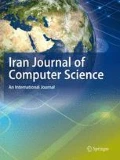Abstract
In the General Backpropagation Neural Network (GBPN), the training process has been found to be dependent on total neurons in the hidden layer (p). The number of weights and biases of hidden and output layers depends on the value of 'p'. Two novel procedures have been suggested in the present study to select the optimum value of 'p', and have been applied in the modeling for forecasting of area-weighted rainfall (chaotic series) with four predictors. In this case, an Optimum Back-Propagation Neural Network-OBPN was obtained from GBPN where two hidden neurons (p = 2) was found to be optimum. It was trained up to global minima (400,000 epochs). During the training and testing periods, the average deviations from the actual were found to be 7.8% and 9.3%, respectively. It was forecasted successfully for the year 2016, 2017, 2018, and 2019 with 6.9%, 0.6%, 11.8%, and 4.6% deviation from the actual, respectively. It was found that the network would not necessarily perform well if the hidden layer contained a large number of neurons. For optimum performance, their number should be low but optimal. Experimental observations during its optimization process and performance are given through this research article.










Similar content being viewed by others
References
Gwo-Fong, L., Lu-Hsien, C.: Application of an artificial neural network to typhoon rainfall forecasting. Hydrol. Process. 19, 1825–1837 (2005)
Ju, Q., Yu, Z., Hao, Z., Zhu, C., Liu, D.: Hydrologic simulations with artificial neural networks. In: Third International Conference on Natural Computation (ICNC 2007), IEEE Conference Publications, Date 24–27 Aug. 2007, 2, pp. 22–27 (2007)
Solaimani, K.: Rainfall-runoff prediction based on artificial neural network (a case study: JarahiWatershed). Am. Euras. J. Agric. Environ. Sci. 5(6), 856–865 (2009)
Duc, L.V.: Applicability of Artificial Neural Network model for simulation of monthly runoff in comparison with some other traditional models. Sci. Technol. Dev. 12(4), 94–106 (2009)
Deshmukh, R.P., Ghatol, A.: Comparative study of Jorden and Elman model of neural network for short term flood forecasting. In: 3rd IEEE International Conference on Computer Science and Information Technology (ICCSIT), Date 9–11 July, IEEE Conference Publications, 9, pp. 400–404 (2010)
Huang, M., Tian, Y.: Design and implementation of a visual modelling tool to support interactive runoff forecasting. In: IEEE International Conference on Date Intelligent Computing and Intelligent Systems (ICIS), Date 29–31 Oct., IEEE Conference Publications 3, pp. 270–274 (2010)
Ghumman, A.R., Ghazaw, Y.M., Sohail, A.R., Watanabe, K.: Runoff forecasting by artificial neural network and conventional model, Search Results Web results. Alexandria Eng. J. 50, 345–350 (2011)
Ilker, A., Kose, M., Ergin, G., Terzi, O.: An artificial neural networks approach to monthly flow estimation. In: International Symposium on Innovations in Intelligent Systems and Applications (INISTA), Date 15–18 June, IEEE Conference Publication, pp. 325–328 (2011)
Sarkar, A., Kumar, R.: Artificial neural networks for event based rainfall-runoff modelling. J. Water Resour. Prot. 4, 891–897 (2012)
Mittal, P., Chowdhury, S., Roy, S., Bhatia, N., Srivastav, R.: Dual artificial neural network for rainfall-runoff forecasting. J. Water Res. Protect. 4, 1024–1028 (2012)
Tayyab, M., Zhou, J., Zeng, X., Adnan, R.: Discharge forecasting by applying artificial neural networks at the Jinsha River Basin, China. Eur. Sci. J. 12(9), 108–127 (2016)
Hashim, F.R., Daud, N.G.N., Ahmed, K.A., Adnan, J., Rizman, Z.I.: Prediction of rainfall based on weather parameter using Artificial Neural Network. J. Fund. Appl. Sci. 9, 493–502 (2017)
Acharya, R., Pal, J., Das, D., Chaudhuri, S.: Long range forecast of indian summer monsoon rainfall using artificial neural network model. Meteorol. Appl. 26, 347–361 (2018)
Abdulkadir, T.S., Salami, A.W., Aremu, A.S., Ayanshola, A.M., Oyejobi: Assessment of neural networks performance in modeling rainfall amounts. J. Res. For. Wildl. Environ. 9(1), 12–22 (2017)
Mishra, P.K., Karmakar, S.: Performance of back-propagation neural network in chaotic data time series forecasting and evaluation over parametric forecast: a case study for rainfall-runoff modelling over a river basin. Int. J. Inf. Technol. (2018). https://doi.org/10.1007/s41870-018-0214-0
Mishra, P.K., Karmakar, S.: Performance of optimum neural network in rainfall–runoff modeling over a river basin. Int. J. Environ. Sci. Technol. 16(3), 1289–1302 (2019)
Hsieh, P.-C., Tong, W.-A., Wang, Y.-C.: A hybrid approach of artificial neural network and multiple regression to forecast typhoon rainfall and groundwater-level change. Hydrol. Sci. J. (2019). https://doi.org/10.1080/02626667.2019.1677905
Zhu, D., Cheng, X., Cheng, F., Zhang, F., Yao, X., Gao, Y., Yu Liu, Y.: Spatial interpolation using conditional generative adversarial neural networks. Int. J. Geogr. Inf. Sci. (2019). https://doi.org/10.1080/13658816.2019.1599122
Karmakar, S., Goswami, S.: Modeling and simulation of OBPN for forecasting of long-range monsoon AWR over a smaller homogeneous region through astrological parameters and its verification for 2019, Iran. J. Comput. Sci. 3(1), 35–57 (2020)
Rumelhart, D., Hinton, G.E., Williams, R.J.: Learning internal representation by error propagation. R J parallel distributed processing, exploration in the microstructure of cognition, pp. 318–362. MIT Press, Cambridge (1986)
Author information
Authors and Affiliations
Corresponding author
Ethics declarations
Conflict of interest
The authors confirm that there is no conflict of interest to declare for this publication.
Additional information
Publisher's Note
Springer Nature remains neutral with regard to jurisdictional claims in published maps and institutional affiliations.
Rights and permissions
About this article
Cite this article
Karmakar, S., Goswami, S. A new procedure for optimization of hidden layer neurons during learning through gradient descent process of neural network and improvement of performance in the chaos forecasting. Iran J Comput Sci 4, 293–303 (2021). https://doi.org/10.1007/s42044-021-00089-z
Received:
Accepted:
Published:
Issue Date:
DOI: https://doi.org/10.1007/s42044-021-00089-z




